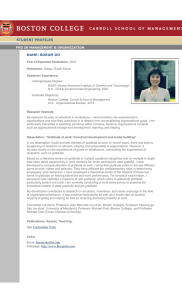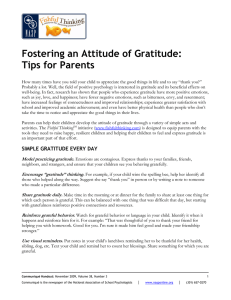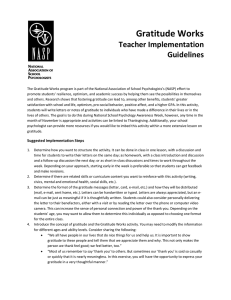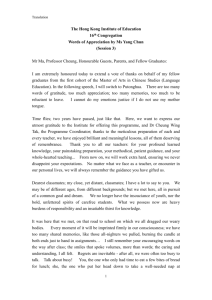Strive. Grow. THRIVE!
advertisement
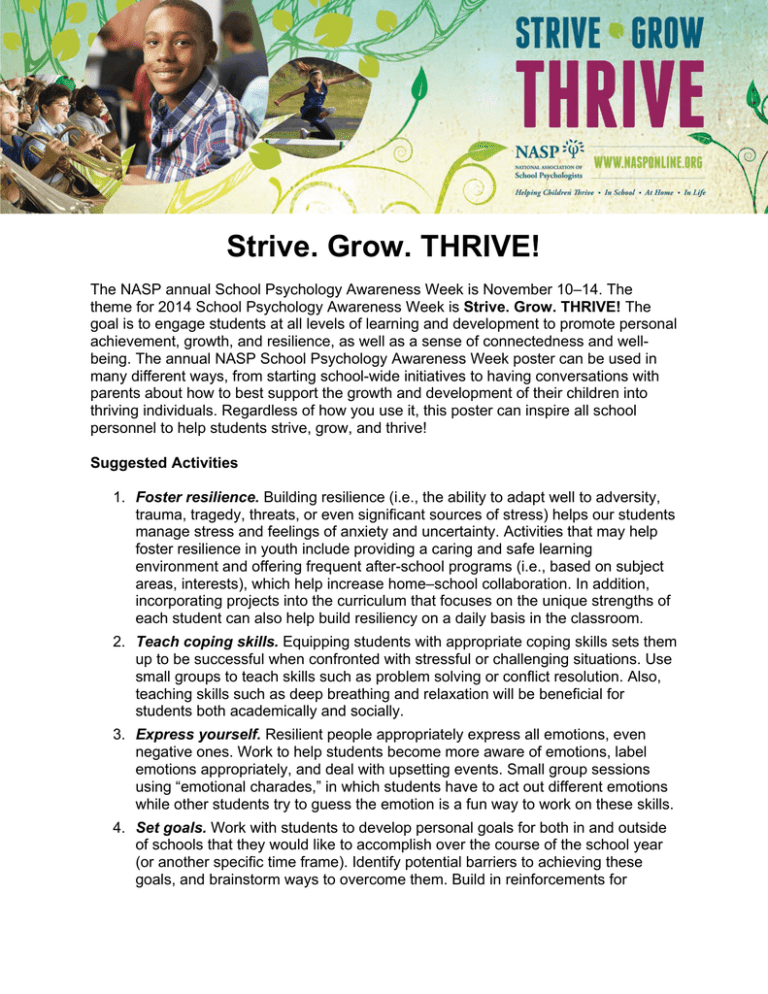
Strive. Grow. THRIVE! The NASP annual School Psychology Awareness Week is November 10–14. The theme for 2014 School Psychology Awareness Week is Strive. Grow. THRIVE! The goal is to engage students at all levels of learning and development to promote personal achievement, growth, and resilience, as well as a sense of connectedness and wellbeing. The annual NASP School Psychology Awareness Week poster can be used in many different ways, from starting school-wide initiatives to having conversations with parents about how to best support the growth and development of their children into thriving individuals. Regardless of how you use it, this poster can inspire all school personnel to help students strive, grow, and thrive! Suggested Activities 1. Foster resilience. Building resilience (i.e., the ability to adapt well to adversity, trauma, tragedy, threats, or even significant sources of stress) helps our students manage stress and feelings of anxiety and uncertainty. Activities that may help foster resilience in youth include providing a caring and safe learning environment and offering frequent after-school programs (i.e., based on subject areas, interests), which help increase home–school collaboration. In addition, incorporating projects into the curriculum that focuses on the unique strengths of each student can also help build resiliency on a daily basis in the classroom. 2. Teach coping skills. Equipping students with appropriate coping skills sets them up to be successful when confronted with stressful or challenging situations. Use small groups to teach skills such as problem solving or conflict resolution. Also, teaching skills such as deep breathing and relaxation will be beneficial for students both academically and socially. 3. Express yourself. Resilient people appropriately express all emotions, even negative ones. Work to help students become more aware of emotions, label emotions appropriately, and deal with upsetting events. Small group sessions using “emotional charades,” in which students have to act out different emotions while other students try to guess the emotion is a fun way to work on these skills. 4. Set goals. Work with students to develop personal goals for both in and outside of schools that they would like to accomplish over the course of the school year (or another specific time frame). Identify potential barriers to achieving these goals, and brainstorm ways to overcome them. Build in reinforcements for achieving short-term goals or steps along the way to accomplishing the larger, long-term goal. 5. Teach students (and staff) how to express gratitude. Expressing gratitude can increase children’s resilience, optimism, and academic success. Teach students about gratitude journaling, in which they write down two or three things (e.g., people, events, or activities) that they are grateful for and why. Having students identify individuals in the school that they are grateful for (peers or staff) and helping them to write a gratitude letter in which they express reasons that they are grateful for that individual is another way to express gratitude. Finally, school administrators, teachers, and other school professionals can promote gratitude in students by modeling it. For example, schools could have periodic gratitude days, during which staff members announce what they are grateful for and ask students to do the same. In particular, it is beneficial for staff members to focus their thoughts and feelings of gratitude to specific people or students in the school and to directly express their gratitude in person. Get additional ideas and resources through NASP’s Gratitude Works program at http://www.nasponline.org/communications/spaw/gratitude-works.aspx 6. Catch them being good. Though often overlooked, praise or positive attention can go a long way in boosting students’ self-esteem. Positive emotions buffer kids against depression and other negative reactions to adversity. Work with students and staff to identify and reinforce positive behaviors when they are exhibited throughout the school. This can be part of a larger school-wide positive behavior interventions and supports program or specific to individual classrooms. 7. Give compliments. Getting a complement makes us feel good! Giving one to another person can result in the same feeling. A fun game to teach this skill to children is compliment tag, which can be done in small counseling groups or in the classroom. Students sit in a circle and decide on one person to be “it” first. This student has to tag another person in the group. However, unlike a typical game of tag where you run and use your hands, this game requires you to tag a person with your words. The student who is “it” will say another student’s name in the group, give him/her a compliment, and then say, “Tag you’re it.” The person who gets tagged responds by saying, “Thank you,” and the person who gave the compliment responds with, “You’re welcome.” The person tagged then picks someone else and so on until everyone has had a chance to give and receive a compliment. 8. Check in/check out. Identify at-risk students and assign a staff member or older student (mentor) to check in with them at the beginning of each school day, and again before school ends. This system will be beneficial for not only the student who is being checked on, but the older student as well. 9. Get fit. Good physical health prepares the body to grow and thrive. Healthy eating habits, regular exercise, and adequate sleep protect kids against the stress of tough situations. Regular exercise also decreases negative emotions such as anxiety, anger, and depression. Partner with cafeteria personnel to increase access to healthy fruits and vegetables for breakfast, lunch, and snacks. Also, collaborate with classroom teachers to incorporate movement activities into their school day. 10. Foster competency. Making sure that children and adolescents achieve academically is great protection against adversity. Children who achieve academic success and who develop individual talents, such as playing sports, drawing, making things, playing musical instruments, or playing games are much more likely to feel competent and be able to deal with stress positively. Social competency is also important. Having friends and staying connected to friends and loved ones can increase resiliency. Work with students to identify areas of interest or strength. School staff may consider collaborating with the school’s music or art teacher to develop fun and engaging activities or projects. 11. Show and tell. Learning to foster strengths is an important part of students’ growth and can increase resiliency and well-being. In small groups or in the larger classroom, have students identify an area of strength that they would like to show to the class. This can be a skill or talent, and after presenting their special strength, that student can be in charge of teaching that skill or talent to the rest of the class. 12. Perseverance and determination. Perseverance means having the selfdiscipline to continue a task in spite of being confronted with difficulties. It is important that we teach students how to persist through challenges and obstacles without giving up. These are important skills to have both inside and outside of school. Lead a discussion about what perseverance means and does not mean. For example, it means to keep working until the assignment is complete, instead of trying only a few times and quitting. With students' help, list the steps needed to learn a new skill such as riding a bicycle, learning to swim, or memorizing the multiplication table. Have students write or draw a picture illustrating a time when they persevered and succeeded even though they felt like giving up. Then, discuss the feelings associated with their achievement such as pride, happiness, self-confidence, and self-esteem. 13. Listen up. Check into the music kids are listening to lately and find examples of optimistic and hopeful lyrics and those without them. Bring the music in and play it for the class. Have the student listen to and discuss the lyrics. Determine whether or not they offer a message of hope. Discuss how words in the music can influence our thoughts and actions. This activity can also be done with popular television shows or movies. 14. Build friendships. Increasing students’ connectedness at school can lead to increased well-being. Encourage students to identify their interests, and form activities or clubs comprised of students with similar interests. Clubs can meet before school, during lunch or recess, or after school. 15. Collaborate with parents. Work with parents to implement activities or strategies within their home or community that reinforce skills being taught at school. For example, parents can model problem-solving skills when confronted with day-to-day problems. Similarly, parents can model emotional competence for their children by using words or appropriate behaviors to express different feelings. This can also be as simple as encouraging parents to take as little as 10 minutes out of every day to engage in an interactive activity with their child (e.g., reading, playing a game, going to the park). 16. Student Power Award. Consider nominating students for the NASP Student Power Award, which was created to honor students who support others and recognize students for progress toward personal goals, optimism, problem solving, eagerness, and dedication. Information on the award can be found at http://www.nasponline.org/communications/spaw/student-power.aspx. Compiled by: Jennifer Cunningham and Christina Burton, Baltimore City Public Schools
